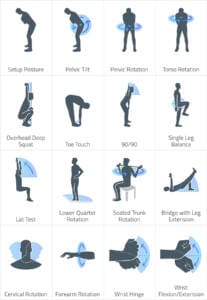
A golf movement screen is specifically designed to assess a golfer’s physical abilities and limitations that affect their golf swing. This type of screen helps identify weaknesses, imbalances, and mobility issues that could impact a golfer’s performance and increase the risk of injury. The goal is to create a tailored training program to improve these areas, leading to better swing mechanics and overall performance.
Key Components of a Golf Movement Screen
- Pelvic Tilt Test: Assesses the ability to control the position of the pelvis during the golf swing.
- Pelvic Rotation Test: Evaluates the ability to rotate the pelvis independently of the upper body.
- Torso Rotation Test: Measures the ability to rotate the upper body independently of the lower body.
- Overhead Deep Squat: Tests overall mobility and stability, particularly in the ankles, hips, and thoracic spine.
- Toe Touch Test: Assesses overall flexibility, especially in the hamstrings and lower back.
- Single Leg Balance Test: Evaluates balance and stability on each leg, which is crucial for weight transfer during the swing.
- 90/90 Test: Assesses internal and external rotation of the shoulders.
- Lat Test: Measures the flexibility of the latissimus dorsi muscles, which can affect posture and shoulder movement.
- Lower Quarter Rotation: Assesses the rotational mobility of the hips, knees, and ankles.
Benefits of a Golf Movement Screen
- Injury Prevention: Identifies physical limitations that could lead to injuries, such as lower back pain or shoulder issues.
- Performance Enhancement: Helps create personalized training programs to improve swing mechanics.
- Improved Efficiency: Ensures that golfers use their bodies more efficiently during the swing, leading to better performance.
- Custom Training Plans: Provides a basis for developing specific exercises and drills tailored to the golfer’s needs.
Conducting a Golf Movement Screen
- Preparation: Ensure the golfer is wearing comfortable, athletic clothing that allows for a full range of motion.
- Instruction: Clearly explain and demonstrate each test to the golfer.
- Evaluation: Use a standardized scoring system to assess each movement. Note any compensations, limitations, or pain.
- Analysis: Review the results to identify areas of weakness, imbalance, or restricted mobility.
- Intervention: Develop a customized training program that includes corrective exercises to address the identified issues.
Example Scoring Criteria
- 0: Pain during the movement
- 1: Significant difficulty performing the movement correctly
- 2: Performs the movement with some compensation or slight difficulties
- 3: Performs the movement correctly without any compensation
Sample Corrective Exercises
- Pelvic Tilt Drill: To improve control of the pelvis.
- Hip Flexor Stretch: To increase hip mobility.
- Thoracic Rotation Exercises: To improve upper body rotation.
- Single Leg Balance Drills: To enhance balance and stability.
- Lat Stretch: To improve shoulder and upper body mobility.
- Hamstring Stretch: To increase flexibility in the hamstrings and lower back.
A well-implemented golf movement screen can significantly improve a golfer’s physical foundation, leading to better swing mechanics, enhanced performance, and reduced risk of injury. Golf professionals, trainers, and physical therapists can use the insights gained from the screen to create effective, individualized training programs.


